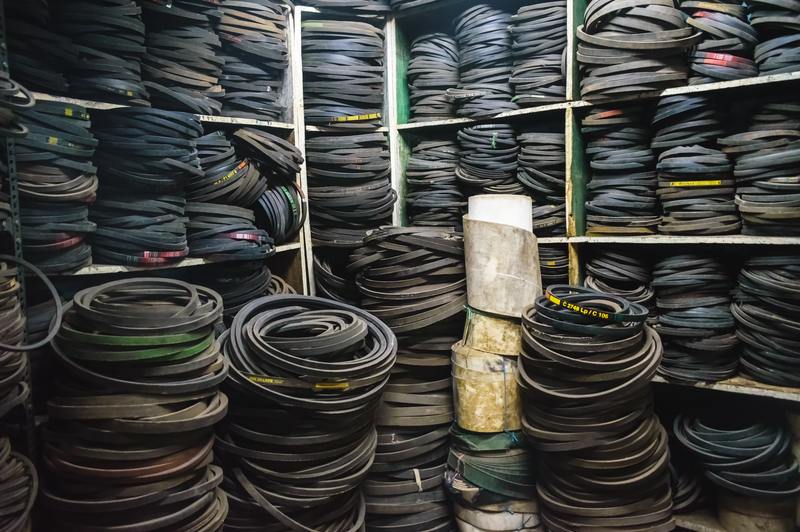We included two solutions on how to remove mildew from rubber. The first is using vinegar, and the second is using bleach.
We absolutely forbid you from using them at the same time. If you’re having difficulty deciding which solution to use, we’ll help you with this article!

What Is Mildew?
Mildew is a type of fungi that is caused by high moisture levels. Most of the time, this translates to household water damage.
So, apart from your mildew contamination problem, you are likely dealing with a water damage issue. If you’re worried about undetected water damage, here’s an article that may help you on how to detect water damaged wood.
Back to the fungus, mildew is sometimes referred to as an early stage of mold, even when it’s not. It’s misconstrued because of its light color, which is how mold often starts.
Moreover, mildew does invite mold after some time. If you leave your mildew unattended, it will make the environment more apt for mold to exist.
Another thing you need to know about mildew is that it tends to grow on natural surfaces. For clothes, this means they stick to those with natural fibers.
Although, you can find them in inorganic objects (e.g., plastic, rubber) due to food sources. These food sources are likely organic debris, which mildew feeds on to survive.
You can look into a similar issue in this linked article on how to remove mildew from plastic, so read and follow it.
How To Detect Mildew On Rubber
As mentioned above, it’s not typical for mildew to grow on inorganic surfaces like rubber. However, they develop in these areas due to food sources, like dust accumulation, grime, or food particles.
For example, in a refrigerator’s rubber gasket, food particles may slip in and stay there for a long time, leading to mildew growth. These areas are also prone to fungi growth because they are not noticeable; hence they are not cleaned as much as they should.
From the causes of mildew, we proceed with detecting mildew on rubber. For areas like rubber gaskets, whether from washing machines or refrigerators, you may notice mildew growth through the distinct smell.
Generally, mildew produces an unpleasant smell that may be earthy depending on its level of maturation. If it’s fully developed and mature, then it becomes more putrid.
If it’s reached that level of smell, it should alarm you on the state of mildew growth on your rubber.
Another way to identify mildew on the rubber is to look for growth itself. It can be a white powdery or downy fungus on your rubber’s surface.
If the rubber is light, it might be challenging to find the mildew. However, it’ll be easy if it’s dark.
What Are The Dangers Of Mildew?
The main danger of untreated mildew contamination is that it can lead to mold growth. The mold is far more damaging than the former and would incur more repair costs.
Also, mildew can trigger allergic reactions ranging from respiratory issues to skin allergies. Having such fungi growth at home could exacerbate their conditions for those who have asthma.
For children, exposure to mildew and mold can lead to the development of asthma.
Steps In Removing Mildew From Rubber
Step #1. Prepare materials
You will need a half-gallon spray bottle, white vinegar, scrub brush, bleach, and measuring cups for the mildew removal process. We urge you to put on rubber gloves, goggles, and a face mask to protect yourself.
Step #2. Remove items
If you get rid of mildew from a refrigerator’s rubber gasket, then you have to unplug it and remove the items it contains to work on the mildew removal process. If the rubber is movable, work on cleaning off the mildew under the sun.
Step #3. Choose a solution
For this step, you have to choose between vinegar and bleach. You cannot use them simultaneously because this will produce chlorine gas.
If it helps, bleach is faster in killing mildew; however, it leads to discoloration. On the other hand, vinegar is slower but does not harm the rubber.
Step #4.1 Use of vinegar
If you choose vinegar, then fill the half-gallon spray bottle with undistilled white vinegar. Spritz the liquid on the mildew-contaminated surface and let it sit for up to four hours.
After that, rinse the rubber with water and a damp cloth. Make sure to dry the rubber to prevent future mildew contamination thoroughly.
Repeat the process as necessary.
Step #4.2 Use of bleach
If you choose bleach, dilute one cup in four cups of water, then pour the mixture into a half-gallon spray bottle. Spritz the solution on the contaminated area and wait for at least fifteen minutes.
Then, scrub the area using a stiff-bristle brush to loosen the mold. Rinse the surface with water, wipe it, and leave it to dry.
Conclusion
The ways on how to remove mildew from rubber that were discussed in this article used vinegar and bleach, but not together. Rubber is a porous material, making it vulnerable to water damage and fungi contamination.
Despite this, it’s pretty easy to remove fungi on its surface as long as the contamination isn’t in the extremes.
